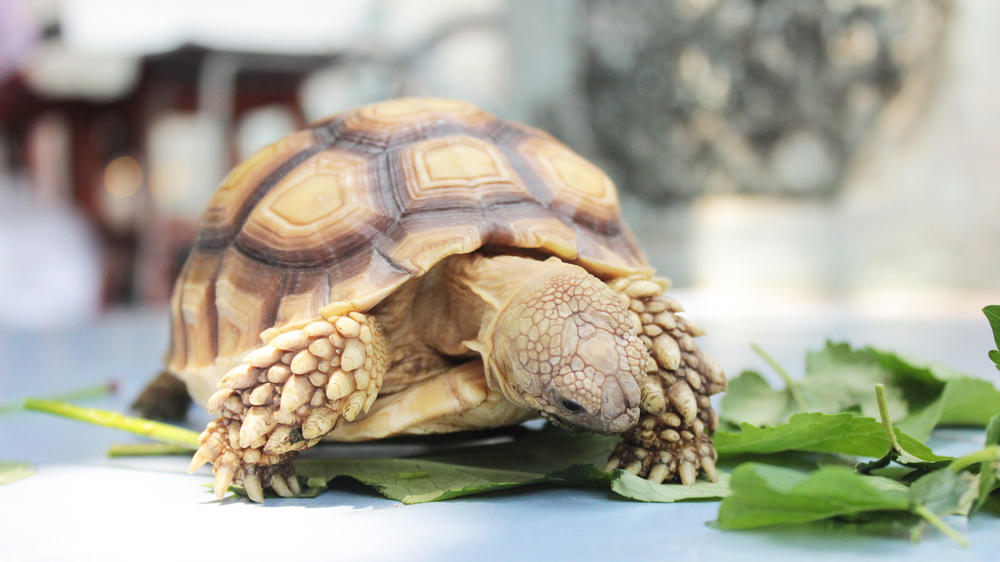The African spurred tortoise (Geochelone sulcata), often known as the Sulcata tortoise, is a magnificent reptile that lives in Africa’s Sahel region. These interesting creatures are recognized for their amazing lifespans, which may regularly exceed 100 years in captivity when properly cared for. As a responsible owner of an African spurred tortoise, you must prioritize their health and prevent infections. This blog discusses the critical components of health care and disease prevention for these intriguing tortoises.
African spurred tortoises live in arid environments, such as savannas and semi-deserts. Understanding their natural environment is critical to reproducing it within their enclosure. They need plenty of space to roam, bask in the sun, and forage for food. Their habitat should contain different hot and cool zones to imitate the temperature fluctuations they encounter in the wild.
Enclosure Setup: A Haven for Your Tortoise.
The enclosure is the primary environment for your tortoise, and its design has a considerable impact on their health. Here’s a summary of the necessary components for a healthy enclosure:
- Adult African-spurred tortoises should be kept in an enclosure measuring at least 8 feet by 10 feet. However, providing more space encourages more natural behaviors and exercise.
- A substrate that resembles their native environment is preferable. Topsoil, sand, and hay are among the available options. Ensure that the substrate is deep enough for these tortoises to burrow, which is their normal behavior.
- Because these tortoises are baskers, they require a basking place that reaches temperatures ranging from 95 to 100°F (35 to 38°C). The temperature in the colder zone might range from 75 to 85°F. Use thermometers to monitor temperature gradients throughout the enclosure.
- Provide UVB lighting that mimics the natural sunshine spectrum. UVB rays are necessary for vitamin D3 synthesis, calcium absorption, and bone health.
- Provide a covered space for your turtle to escape the heat and feel safe. This can be a simple concealed box or a specific shaded place within the cage.
Make sure your tortoise has access to a small water dish where it may soak and drink. Maintain cleanliness in the water dish.
Diet: A Balanced Approach to Tortoise Health
Nutrition is extremely important to the health of an African spurred tortoise. Here are some significant dietary considerations:
- Variety is important. Provide a varied meal that includes a high-quality professional tortoise food pellet as well as fresh, leafy greens such as dandelion, collard, and hibiscus leaves.
- Hay is an important part of their diet, facilitating digestion and supplying necessary roughage. Choose grass hay, such as oat or Timothy hay.
- Calcium For Strong Bones. Two or three times each week, dust their greens and hay with a calcium supplement to guarantee adequate calcium consumption for good shell and bone development. Consult your doctor to choose the best calcium supplement for your tortoise based on its age and overall health.
- Fruits and sugary foods should be served as infrequent treats.
Hygiene and Sanitation
Maintaining a clean habitat is essential for preventing disease in your tortoise. Here are some hygiene measures you can follow:
- To avoid bacterial growth, regularly remove feces and uneaten food from the enclosure.
- To ensure hygiene, change the substrate fully every 3-4 months, or more frequently as needed.
- Give your tortoise shallow, lukewarm soaks (about 80°F or 27°C) a few times per week, especially during shedding. This loosens dead skin and improves overall hygiene. However, avoid oversoaking, as this will soften their shells.
Recognizing Signs of Illness
Early diagnosis of problems with health is critical to successful treatment. Here are some indicators of disease to look out for in your African spurred tortoise.
- A healthy tortoise should have a decent appetite. A rapid drop in food intake may suggest an underlying health problem.
- If your tortoise appears lethargic or inactive for an extended period of time, it may be ill.
- Wheezing, trouble breathing, or increased mucus production may suggest respiratory difficulties.
- Softening of the shell, pyramiding (abnormal shell growth), and fissures in the shell may indicate metabolic bone disease or inappropriate treatment.
- Cloudy eyes, heavy mucus production, or puffiness around the eyes may suggest an eye infection or respiratory problem.
Schedule regular checkups with your veterinarian.
Annual checks with a physician who specializes in reptile care are vital for your African-spurred tortoise. These exams allow the doctor to analyze your tortoise’s overall health, detect any potential problems early on, and advise you on suitable care practices tailored to your tortoise’s demands. During the checkup, the veterinarian may do a physical examination, look for parasites, and recommend diagnostic testing as needed. Early detection and treatment of any health issues improves your tortoise’s prognosis and ensures their long-term well-being.
Understanding their natural habitat, building an appropriate enclosure, giving a balanced diet, keeping hygiene, and arranging regular veterinary visits will help your African-spurred tortoise thrive for many years. Remember that these lovely creatures rely on you for their well-being. With the right care and attention, you can have their majestic presence adorn your life for years.
Conclusion:
African spurred tortoises make fascinating companions, but their long lifespans require a dedication to their health. You may ensure their well-being by reproducing their natural surroundings within their enclosure, providing a balanced meal, and keeping their habitat clean. Regular veterinary examinations enable early diagnosis of any health issues, resulting in timely intervention and a happier future for your beloved tortoise. Remember that responsible ownership is a lifelong endeavor, and with devotion, you can see your African-spurred tortoise thrive for years to come, leaving an indelible impression on your life with their engaging presence.
Disclaimer
The information provided in this blog is intended for general knowledge purposes only and is based on information readily available online. The author is not a veterinarian or a specialist in African spurred tortoise care. For specific advice regarding the health and well-being of your tortoise, please consult a qualified reptile veterinarian.


